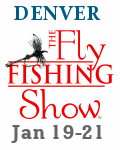Flyfishing the Futa - A Trip to Chile
by Karen ChristophersonJanuary 16th - I get a call from a client (my real job is that of a geophysicist) saying, "Can you go to Chile on the 25th?" My rapid response is, "YES!" while in the back of my mind I am thinking not of work, but flyfishing.
Step One - Call the travel agent and make bookings to Santiago. I will need four days there for work. Step Two - Contact several outfitters in southern Chile, short notice for a trip so far away. One outfitter, Patago, Inc., whom I had met just weeks earlier at the Fly Fishing Show in Denver has no clients booked for four days - the EXACT four days I can be there. YAHOO - my fishing dreams are about to come true.
It's quite a journey to go flyfishing in Chile. Getting to Santiago is just the first step, about 20 hours of traveling from Denver via Miami. Then, fly from Santiago to Puerto Montt (about 600 miles south, 1.5 hours by air) and catch an even smaller plane to Chaiten (another 100 miles south and 45 minutes flying.) Next, 2.5 hours by van to the east, close to the Argentine border and home to one of the largest, most beautiful rivers I have ever seen, the Futaleufu.
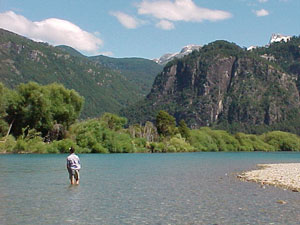 |
The water reminds you of the Caribbean but glance up and the mountains will make you realize that you are somewhere very remote and very special. Pictures cannot do justice to how majestic and beautiful the river and country are. |
The Futaleufu ("Futa" for short) starts in Argentina and then bends westward to travel through Chile to Lago (Lake) Yelcho. This whole part of southern Chile is comprised of glacially carved valleys and fjords. It's reminiscent of coastal Alaska and BC with better weather. The mountain walls are steep and topped with glaciers and snowfields. The Futa is aqua blue, and incredibly clear. It is summer - their equivalent of our July.
Flyfishing here is relatively new as the road was constructed only 20 years ago. Most of the visitors are kayakers and rafters who flock to the Futa for its series of class V+ waters. However, several long stretches of the river are flat water and home to Brown and Rainbow trout. Both of these trout species were introduced on the Argentine side almost 100 years ago - the Browns from Europe; the Rainbows from McCloud River stock out of California. Over the years they have flourished and grown to become wild fish that do not know what an artificial fly is - chances are that a fish you hook will have never tasted a wooly bugger or Chernobyl ant before.
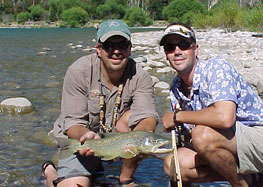 |
Joe Delling and Joshua Grounds, two of the Patago guides. Joe caught this big Brown while wading on the edge of a gravel bar. He was very excited - it's nice to see an experienced guide get excited! |
This is a BIG river - summer flow is 10,000 to 12,000 CFS - it's hard to find that in Colorado or Wyoming, maybe only the downstream Colorado. About the only way to fish the Futa effectively is to float it. My guides are actually from Durango, spending the winter working for Patago, Inc. in Chile. Fishing with an outfitter in Chile normally means that they supply everything - your housing, food, transportation. You supply your gear and enthusiasm.
Floating on the Futa was like a dream - the Caribbean-colored water reminded me of bonefishing, not trout fishing. Some of the pools were still and 20 feet deep. Peering over the raft edge you could see the trout suspended. A quiet cast and a stripped streamer on the surface would draw them in a chase to the surface. It's a wonderful thing to watch trout chase flies, especially for a long distance.
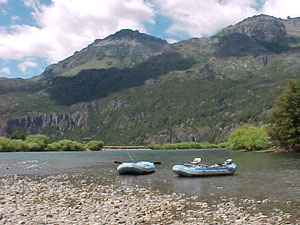 |
Most of the fishing was from the rafts into riffles, seams, banks, and pools. However, occasional stops on bars and islands provided wading opportunities. |
Big river and wild trout country means big rods - a 6 or 7 wt with strong leader and tippet. These fish are fighters - many people remark that hooking a 14" Rainbow on the Futa seems to put up the fight of a 22" Rainbow at home. And the flies of choice are mostly large too - wooly buggers, Madame X's, Bitch Creeks, large stimulators mostly plopped, moved, and stripped to get the trout interested in chasing what they perceive as a good meal. After much complaining from me about the heavy flies, my guide allowed me to use a huge Chernobyl ant - luckily the fish were interested in dries that day.
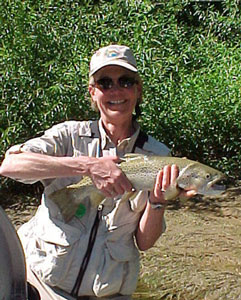 |
Getting the trout interested in the fly was pretty easy; hooking them a bit more difficult. Landing them - that's the real trick! I caught quite a few Rainbows and Browns, and missed or lost many more. Most of the landed fish were between 12" and 18". But I did manage to land one large brown with lots of coaching from my guide. |
If you go:
Most outfitters provide trips in the Chilean summer, December through March. There are several lodge/guide services between Puerto Montt and Coihaique.

